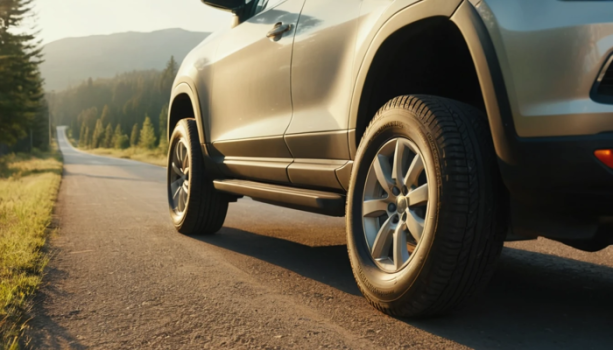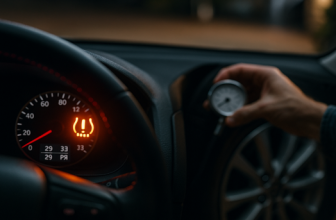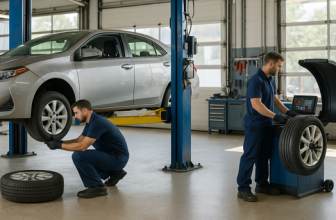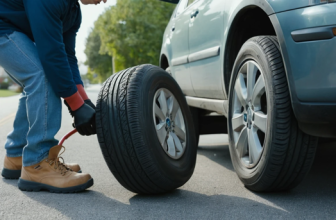When to replace tires on SUV — Learn clear signs, tread depth rules, age limits, and safety tips to replace tires the right time.
Replace SUV tires when tread depth falls to 4/32″ for safe wet traction and always by 2/32″ (legal minimum). Replace if you see cracks, bulges, uneven wear, or if tires are older than 6 years. Heavier use, off-road driving, or visible damage shortens that timeline.
When To Replace Tires On SUV: Smart, Confident
Are You Unsure If Your SUV Tires Are Still Safe, Or Just Fine To Keep Driving?
Here’s the clear, direct answer so you can stop guessing. Replace SUV tires when tread depth hits 4/32″ for safe wet handling, or immediately at 2/32″ which is the common legal limit. Also replace tires with visible sidewall damage, bulges, or severe uneven wear, and consider replacement after 6 years of use even with decent tread. Below you’ll find a step-by-step guide, checklists, and easy rules you can use today.
Signs Your SUV Tires Need Replacement 🚨
If your SUV feels less stable, check the tires first. Look for tread wear indicators, cracks, bulges, and punctures. These are clear, visible signs that a tire may fail soon. Ignoring them increases risk on wet roads and at high speeds.
Also watch for frequent low pressure. That can mean a slow leak. Vibrations and pulling to one side are warning signals too. Don’t delay a professional check if you notice these issues. 🛑
Tread Depth: The Number That Matters 📏
Tread depth affects traction in wet and snowy conditions. Use a tread depth gauge or a quarter for a quick check. If the top of Washington’s head is visible on a quarter, your tread is under 4/32″.
Most experts recommend replacing SUV tires at 4/32″ for safe wet braking. At 2/32″, the tire is legally worn out in many places. Keep spare checks every month. 🔧
Legal Minimum Vs. Safe Depth ⚖️
Know the difference between legal and safe. The legal minimum is often 2/32″. That number is about avoiding fines and basic road legality.
Safe depth is higher. For SUVs, 4/32″ is a safer limit for wet roads. For driving in snow, aim for 6/32″ or better. Safety beats cheap short-term savings.
Tire Age: Don’t Ignore The Calendar 🗓️
Tire rubber breaks down with time, not just miles. Manufacturers often recommend inspection after 5 years. Consider replacement by 6–10 years even with good tread.
Look for the DOT code on the sidewall for manufacture date. If you can’t read it, ask a tire shop to check the age. Old tires risk sudden failure. ⏳
Visible Damage And Sidewall Issues 🔍
Cuts, deep cracks, and sidewall bulges are immediate red flags. The sidewall cannot be safely repaired in many cases. A bulge means internal cord separation.
If you see this damage, replace the tire immediately. Driving on a damaged tire risks blowouts at highway speeds. Safety must be the priority. ⚠️
| Damage Type | Replace Immediately? | Notes |
| Sidewall Bulge | Yes | Internal damage; unsafe to repair |
| Large Cut Near Sidewall | Yes | High risk of failure |
| Small Puncture In Tread | Maybe | Many punctures are repairable |
| Cracks In Rubber | Usually | Age-related cracking needs attention |
Uneven Wear Patterns And What They Mean 🛠️
Uneven tread wear reveals other problems. Toe, camber, and alignment issues show up as one-sided wear. Overinflation causes center wear; underinflation wears edges.
If wear is uneven, inspect alignment, suspension, and pressure. Fix the root cause before fitting new tires. Otherwise, new tires will wear quickly. 🧭
Vibration, Noise, And Handling Problems 🚗💨
Shaking at certain speeds can signal a tire issue. It may also come from unbalanced wheels or bad suspension parts. Loud humming or new noises deserve a quick check.
If a vibration disappears after replacing tires, they were likely the cause. Don’t drive long with persistent vibration. It can be dangerous and costly. 🔊
Load, Driving Style, And Terrain Effects 🏞️
SUVs often carry heavier loads than sedans. Heavy loads increase tire stress and wear. Frequent towing or off-road driving reduces tire life.
If you drive rough roads or carry lots of weight, plan to replace tires sooner. Adjust your maintenance schedule to match your driving habits. 🚙
Seasonal Considerations: Rain, Snow, Heat ❄️☀️
Weather matters for tire life and safety. Hot pavement speeds rubber wear in summer. Snow and ice demand deeper tread and specific winter tires.
Switch to winter tires when roads freeze regularly. In wet seasons, replace earlier if traction drops. Seasonal choices affect safety more than you might expect. ❄️
Tire Pressure And Maintenance Tips 🧰
Proper inflation extends tire life and improves safety. Check pressure monthly and before long trips. Use the vehicle placard for the correct PSI.
Rotate tires every 5,000–7,500 miles to encourage even wear. Also inspect for nails, cuts, and uneven patches during rotation. Small steps prevent costly replacements. 🔁
| Check Frequency | What To Do | Why It Matters |
| Monthly | Check PSI and visual wear | Prevents uneven wear and failures |
| Every 5k–7.5k miles | Rotate Tires | Extends life and ensures even wear |
| Before Long Trip | Inspect for damage | Avoid roadside failures |
When To Replace All Four Vs Two Tires 🔄
Should you replace two or all four tires? Match tread depth across axles when possible. Mismatched tire diameter can harm all-wheel-drive systems.
Often, replace all four for balanced handling. Replace two only if the remaining pair has deep tread and similar wear. Ask a pro if you are unsure. ⚖️
Choosing The Right Replacement Tires 🏷️
Pick tires for your SUV weight and use. Look for load rating, speed rating, and tread suited to your climate. Choose a reputable brand if budget allows.
Read labels for service description and UTQG ratings. If you tow or carry heavy loads, select higher load-rated tires. Your choice affects safety, ride, and fuel economy. 🔍
Cost, Warranty, And Value Considerations 💵
Tire prices vary widely based on brand and type. Expect to pay more for heavy-duty or all-terrain SUV tires. Balance price with expected mileage warranty.
Check mileage warranties and road hazard coverage. Sometimes pay-per-mile cost makes a pricier tire better value. Factor installation and disposal fees too. 💸
DIY Checks And The Professional Inspection ✅
You can do quick checks at home. Use a penny or tread gauge, inspect sidewalls, and listen for unusual noise. Keep a log of pressure and wear.
Still, get a professional inspection annually or when unsure. Pros check internal damage and wheel balance. Their tools reveal issues you can’t see. 🛠️
Installation, Balancing, And Alignment Steps 🧩
Proper installation matters as much as the tire choice. Mounting must be precise, and balancing prevents vibration. Alignment avoids rapid uneven wear.
After fitting new tires, ask for a test drive and recheck torque after 50–100 miles. A little extra care ensures the best ride and longer tire life. 🔧
| Service Step | Why It Matters |
| Proper Mounting | Prevents bead leaks and damage |
| Wheel Balancing | Stops vibration and premature wear |
| Alignment | Ensures even tread wear and handling |
| Torque Check | Keeps wheels securely fastened |
Long-Term Care To Extend Tire Life 🌱
Good maintenance stretches tire life and saves money. Keep tires inflated, rotate them regularly, and drive smoothly. Avoid hard braking and fast cornering when possible.
Store seasonal tires properly to prevent flat spots and cracking. A few small habits can add thousands of safe miles. 🌟
Quick Replacement Checklist Before You Buy ✍️
Before you buy, run through a short checklist. Confirm tread depth, tire age, and visible damage. Note your driving style and local weather.
Bring this checklist to the shop to get matched recommendations. A checklist keeps the process quick and smart. ✅
- Tread Depth: Use a gauge or coin test.
- Age: Check DOT date on sidewall.
- Damage: Look for bulges, cuts, or exposed cords.
- Use: Note towing, off-roading, or frequent highway driving.
Tip: If in doubt, replace — inexpensive prevention beats expensive accidents. 🔥
Conclusion — Key Takeaways
Replacing SUV tires is about safety, not just looks. Replace at 4/32″ for safer wet driving and by 2/32″ legally. Replace older tires after about 6 years, or sooner with visible damage. Keep pressures correct, rotate tires, and inspect monthly. Choose tires to match your load and climate, and always balance and align after installation.
FAQs
How Often Should I Replace SUV Tires?
Most SUVs need replacement every 6–10 years by age, or sooner by tread or damage. Check monthly and rotate tires to track wear. Replace earlier for heavy or off-road use.
What Tread Depth Means Replace Tire?
Replace when tread hits 4/32″ for wet safety and at 2/32″ legally. Use a gauge or coin test. Deeper tread is better in snow.
Can I Replace Only Two SUV Tires?
You can replace two if the remaining pair has similar tread depth. For AWD SUVs, replacing all four is usually safer. Mismatched diameters can stress the drivetrain.
How Does Tire Age Affect Safety?
Rubber hardens and cracks with age even if tread looks fine. Most pros recommend inspection after 5 years. Replace by 6–10 years depending on condition.
What Are Clear Signs Of Tire Failure?
Sidewall bulges, deep cuts, repeated slow leaks, and severe vibration are signs. If you see these, stop driving and replace the tire. They predict blowouts.





